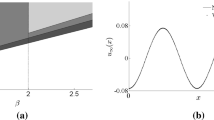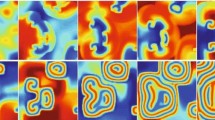Abstract
The formation of stable patterns is considered in a reaction-diffusion system based on the cubic autocatalator, A+2B → 3B, B → C, with the reaction taking place within a closed region, the reactant A being replenished by the slow decay of precursor P via the reaction P → A. The linear stability of the spatially uniform Steady state % MathType!MTEF!2!1!+-% feaafiart1ev1aaatCvAUfeBSjuyZL2yd9gzLbvyNv2CaerbuLwBLn% hiov2DGi1BTfMBaeXafv3ySLgzGmvETj2BSbqefm0B1jxALjhiov2D% aebbfv3ySLgzGueE0jxyaibaiGc9yrFr0xXdbba91rFfpec8Eeeu0x% Xdbba9frFj0-OqFfea0dXdd9vqaq-JfrVkFHe9pgea0dXdar-Jb9hs% 0dXdbPYxe9vr0-vr0-vqpWqaaeaabiGaciaacaqabeaadaqaaqGaaO% qaamaabmGabaGaamyyaiaacYcacaWGIbaacaGLOaGaayzkaaGaeyyp% a0ZaaeWaceaacqaH8oqBdaahaaWcbeqaaiabgkHiTiaaigdaaaGcca% GGSaGaeqiVd0gacaGLOaGaayzkaaaaaa!48C3!\[\left( {a,b} \right) = \left( {\mu ^{ - 1} ,\mu } \right)\], where a and b are the dimensionless concentrations of reactant A and autocatalyst B and μ is a parameter representing the initial concentration of the precursor P, is discussed first. It is shown that a necessary condition for the bifurcation of this steady state to stable, spatially non-uniform, solutions (patterns) is that the parameter % MathType!MTEF!2!1!+-% feaafiart1ev1aaatCvAUfeBSjuyZL2yd9gzLbvyNv2CaerbuLwBLn% hiov2DGi1BTfMBaeXafv3ySLgzGmvETj2BSbqefm0B1jxALjhiov2D% aebbfv3ySLgzGueE0jxyaibaiGc9yrFr0xXdbba91rFfpec8Eeeu0x% Xdbba9frFj0-OqFfea0dXdd9vqaq-JfrVkFHe9pgea0dXdar-Jb9hs% 0dXdbPYxe9vr0-vr0-vqpWqaaeaabiGaciaacaqabeaadaqaaqGaaO% qaaiaadseacqGH8aapcaaIZaGaeyOeI0IaaGOmamaakaaabaGaaGOm% aaWcbeaaaaa!4139!\[D < 3 - 2\sqrt 2 \] where D=D b/Da (D a and D b are the diffusion coefficients of chemical species A and B respectively). The values of μ at which these bifurcations occur are derived in terms of D and λ (a parameter reflecting the size of the system). Further information about the nature of the spatially non-uniform solutions close to their bifurcation points is obtained from a weakly nonlinear analysis. This reveals that both supercritical and subcritical bifurcations are possible. The bifurcation branches are then followed numerically using a path-following method, with μ as the bifurcation parameter, for representative values of D and λ. It is found that the stable patterns can lose stability through supercritical Hopf bifurcations and these stable, temporally periodic, spatially non-uniform solutions are also followed numerically.
Similar content being viewed by others
References
P. Gray, Review lecture: Instabilities and oscillations in chemical reactions in closed and open systems. Proc. R. Soc. Lond. A415 (1988) 1–34.
A. Hanna, A. Saul and K. Showalter, Detailed studies of propagating fronts in the iodate oxidation of arsenous acid. J. American Chemical Soc. 104 (1982) 3838–3844.
A. Saul and K. Showalter, Propagating reaction-diffusion fronts, In: R.J Field and M. Burger (eds.), Oscillations and Travelling Waves in Chemical Systems. New York, (1984).
J. Schnakenberg, Simple chemical reaction systems with limit cycle behaviour. J. Theoretical Biology 81 (1979), 389–400.
J.D. Murray, Parameter space for Turing instability in reaction-diffusion mechanisms: a comparison of models. J. Theoretical Biology 98 (1982) 143–163.
J.D. Murray, Mathematical Biology. Berlin, Springer-Verlag (1989).
P. Arcuri and J.D. Murray, Pattern sensitivity to boundary and initial conditions in reaction-diffusion models. J. Math. Biology 24 (1986), 141–165.
E.E. Sel'kov, Self-oscillations in glycolysis. European J. Biology 4 (1968) 79–86.
A. D'Anna, P.G. Lignola and S.K. Scott, The application of singularity theory to isothermal autocatalytic open systems. Proc. R. Soc. Lond. A403 (1986) 341–363.
P. Gray and S.K. Scott, Autocatalytic reactions in the isothermal continuous stirred tank reactor: isolas and other forms of multistability. Chemical Engineering Science 38 (1983) 29–43.
P. Gray and S.K. Scott, Autocatalytic reactions in the isothermal continuous stirred tank reactor: oscillations in the system A+2B → 3B, B → C. Chemical Engineering Science 39 (1984) 1087–1097.
P. Gray and S.K. Scott, Sustained oscillations and other exotic patterns of behaviour in isothermal reactions. J. Physics and Chemistry 89 (1985) 22–32.
P. Gray and S.K. Scott, Chemical oscillations and unstabilities, Oxford, Clarendon Press (1991).
B.F. Gray and M.J. Roberts, An analysis of chemical kinetic systems over the entire parameter space: II isothermal oscillations. Proc. R. Soc. Lond A416 (1988) 403–424.
J.H. Merkin, D.J. Needham and S.K. Scott, Oscillatory chemical reactions in closed vessels. Proc. R. Soc. Lond A406 (1986) 299–323.
J.H. Merkin, D.J. Needham and S.K. Scott, On the creation, growth and extinction of oscillatory solutions for a simple pooled chemical reaction scheme. S.I.A.M. J. Appl. Math. 47 (1987) 1040–1060.
J.H. Merkin, D.J. Needham and S.K. Scott, On the structural stability of a simple pooled chemical system. J. Engineering Math. 21 (1987) 115–127.
J.H. Merkin and D.J. Needham, Reaction-diffusion in a simple pooled chemical system. Dynamics and Stability of Systems 4 (1989) 141–167.
D.J. Needham and J.H. Merkin, Pattern formation through reaction and diffusion in a simple pooled-chemical system. Dynamics and Stability of Systems 4 (1989) 259–284.
A.H. Nayfeh, Perturbation Methods. New York, Wiley-Interscience (1983).
J.F.G. Auchmuty and G. Nicolis, Bifurcation analysis of nonlinear reaction-diffusion equations-I. evolution equations and the steady state solutions. Bull. Math. Biology 37 (1975) 232–365.
D.G. Schaeffer and M.A. Golubitsky, Bifurcation analysis near a double eigenvalue of a model chemical reaction. Archive for Rational Mechanics and Analysis 74 (1981) 315–347.
L. Bauer, H.B. Keller and E.L. Reiss, Multiple eigenvalues lead to secondary bifurcation. S.I.A.M. Review 17 (1975) 101–122.
C. Canuto, M.Y. Hussaini, A. Quarteroni and T.A. Zang, Spectral Methods in Fluid Mechanics. Berlin, Springer-Verlag (1987).
C. Kaas-Petersen, PATH-users guide. CNLS (LEEDS) report (1987).
J.C. Eilbeck, The pseudo-spectral method and path following in reaction-diffusion bifurcation studies. S.I.A.M. J. Sci. Stat. Comput. 7 (1986) 599–610.
Author information
Authors and Affiliations
Rights and permissions
About this article
Cite this article
Hill, R., Merkin, J.H. & Needham, D.J. Stable pattern and standing wave formation in a simple isothermal cubic autocatalytic reaction scheme. J Eng Math 29, 413–436 (1995). https://doi.org/10.1007/BF00043976
Received:
Accepted:
Issue Date:
DOI: https://doi.org/10.1007/BF00043976




